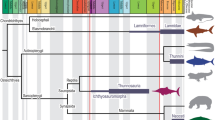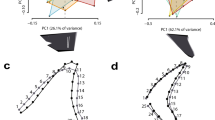Abstract
The earliest fully aquatic cetaceans arose during the Middle Eocene; however, the earliest stage of their divergence is obscure. Here, we provide a detailed redescription of an unusual early cetacean, “Platyosphys einori”, from the Late Eocene of Ukraine (37.8–35.8 million years ago), with new data on its body size, skeletal microanatomy and suggestions on phylogenetic relationships. The procedure of regression analysis has been developed for the body size estimation from the size of the longest vertebra and the width of a cervical vertebra. “Platyosphys einori”, identified here as Basilosauridae incertae sedis, is a fully aquatic cetacean with a pronounced neck, poorly developed or low frequency underwater hearing, and it has a mix of plesiomorphic and derived traits. It is unusually large for a cetacean of that time, approximately 10 m long, and it is possibly very young and fast-growing for its body size. There is no pachyosteosclerotic cortex in vertebrae, and there is a large amount of spongy tissue in the rib. Therefore, “Platyosphys einori”, even if juvenile, is at the intermediate stage between early cetaceans with osteosclerotic bones and modern whales with osteoporotic skeleton. Thus, “Platyosphys einori” shows adaptations to life in water typical for modern whales but unique for the Eocene cetaceans.







Similar content being viewed by others
References
Aleksandrova, G. N., & Zaporozhets, N. I. (2008). Palynological characteristics of upper cretaceous and paleogene deposits on the west of the Sambian Peninsula (Kaliningrad region), Part 1. Stratigraphy and Geological Correlation, 16(3), 295–316. https://doi.org/10.1134/S0869593808030052.
Andreyeva-Grigorovich, A., Zaporozhets, N., Shevchenko, T., Aleksandrova, G., Vasylieva, O., Iakovleva, A., et al. (2011). Atlas of Paleogene dinocysts of the Ukraine and adjacent countries. Kyiv: Naukova Dumka.
Aslanova, S., & Mchedlidze, G. (1976). A new genus of the family Delphinidae in the Caucasus. Voprosy Paleontologii i Stratigrafii Azerbaydzhana, 1, 181–188.
Borsuk-Bialynicka, M. (1988). New remains of Archaeoceti from the Paleogene of Antarctica. Polish Polar Research, 9(4), 437–445.
Brandt, J. (1873). Untersuchungen u¨ber die fossilen und subfossilen cetacean Europa’s . M´emoires de L’Acad´emie Imp´eriale des Sciences de Saint-Petersbourg, VIIe série, 20(1), 1–372. https://doi.org/10.5962/bhl.title.39524.
Brisson, A. D. (1796). Regnum Animale in Classes IX distributum sive synopsis methodica. Edito altero auctior. Leiden: Theodorum Haak.
Buchholtz, E. A. (2001). Vertebral osteology and swimming style in living and fossil whales (Order: Cetacea). Journal of Zoology, 253(2), 175–190. https://doi.org/10.1017/S0952836901000164.
Buono, M. R., Fernández, M. S., Reguero, M. A., Marenssi, S. A., Santillana, S. N., & Mörs, T. (2016). Eocene basilosaurid whales from the la Meseta formation, Marambio (Seymour) Island. Antarctica. Ameghiniana, 53(3), 296–315. https://doi.org/10.5710/AMGH.02.02.2016.2922.
Clementz, M. T., Fordyce, R. E., Peek, S. L., & Fox, D. L. (2014). Ancient marine isoscapes and isotopic evidence of bulk-feeding by Oligocene cetaceans. Palaeogeography, Palaeoclimatology, Palaeoecology, 400, 28–40. https://doi.org/10.1016/j.palaeo.2012.09.009.
Cope, E. D. (1868). Second contribution to the history of the Vertebrata of the Miocene period of the United States. Proceedings of the Academy of Natural Sciences of Philadelphia, 20, 184–194.
Makarenko, D. E. (Ed.). (1987). Stratigraphic schem of the Paleogene deposits of Ukraine (Unified). Kyiv: Naukova Dumka.
De Buffrénil, V., De Ricqlès, A., Ray, C. E., & Domning, D. P. (1990). Bone histology of the ribs of the archaeocetes (Mammalia: Cetacea). Journal of Vertebrate Paleontology, 10(4), 455–466. https://doi.org/10.1080/02724634.1990.10011828.
De Ricqlès, A., & De Buffrénil, V. (2001). Bone histology, heterochronies and the return of tetrapods to life in water: Where are we? Secondary adaptation of tetrapods to life in water (pp. 289–310). Munich, Germany: Verlag Friedrich Pfeil.
Domning, D. P., & de Buffrénil, V. (1991). Hydrostasis in the sirenia: Quantitative data and functional interpretations. Marine Mammal Science, 7(4), 331–368. https://doi.org/10.1111/j.1748-7692.1991.tb00111.x.
Fahlke, J. M., Gingerich, P. D., Welsh, R. C., & Wood, A. R. (2011). Cranial asymmetry in eocene archaeocete whales and the evolution of directional hearing in water. Proceedings of the National Academy of Sciences of the United States of America, 108(35), 14545–14548. https://doi.org/10.1073/pnas.1108927108.
Fedorovsky, A. (1912). A record of a fossil cetacean in Zmiev uyezd of Kharkov government. Trudy Obshchestva Ispytateley Prirody Kharkovskogo Univeristeta, 14, 253–287.
Fordyce, R. E., & de Muizon, C. (2001). Evolutionary history of cetaceans: A review. Secondary adaptation of tetrapods to life in water, 2001, 169–233.
Fordyce, R. E., & Marx, F. G. (2018). Gigantism precedes filter feeding in baleen whale evolution. Current Biology, 28(10), 1670-1676.e2. https://doi.org/10.1016/j.cub.2018.04.027.
Galatius, A., & Kinze, C. C. (2003). Ankylosis patterns in the postcranial skeleton and hyoid bones of the harbour porpoise (Phocoena phocoena) in the Baltic and North Sea. Canadian Journal of Zoology, 81(11), 1851–1861. https://doi.org/10.1139/z03-181.
George, J. C., Stimmelmayr, R., Suydam, R., Usip, S., Givens, G., Sformo, T., & Thewissen, J. G. M. (2016). Severe bone loss as part of the life history strategy of bowhead whales. PLoS ONE, 11(6), 1–14. https://doi.org/10.1371/journal.pone.0156753.
Gingerich, P. D., Arif, M., Bhatti, M. A., Anwar, M., & Sanders, W. J. (1997). Basilosaurus drazindai and Basiloterus hussaini, new Archaeoceti (Mammalia, Cetacea) from the middle Eocene Drazinda Formation, with a revised interpretation of ages of whale-bearing strata in the Kirthar Group of the Sulaiman Range, Punjab (Pakistan). Contributions from the Museum of Paleontology. The University of Michigan., 30(2), 55–81.
Gingerich, P. D., Ul-Haq, M., Von Koenigswald, W., Sanders, W. J., Smith, B. H., & Zalmout, I. S. (2009). New protocetid whale from the middle Eocene of Pakistan: Birth on land, precocial development, and sexual dimorphism. PLoS ONE. https://doi.org/10.1371/journal.pone.0004366.
Gingerich, P. D., & Zouhri, S. (2015). New fauna of archaeocete whales (Mammalia, Cetacea) from the Bartonian middle Eocene of southern Morocco. Journal of African Earth Sciences, 111, 273–286. https://doi.org/10.1016/j.jafrearsci.2015.08.006.
Gol’din, P., Startsev, D., & Krakhmalnaya, T. (2014a). The anatomy of the late miocene baleen whale Cetotherium riabinini from Ukraine. Acta Palaeontologica Polonica, 59(4), 795–814. https://doi.org/10.4202/app.2012.0107.
Gol’din, P., & Zvonok, E. (2013). Basilotritus uheni, a new cetacean (Cetacea, Basilosauridae) from the late middle Eocene of eastern Europe. Journal of Paleontology, 87(2), 254–268. https://doi.org/10.1666/12-080r.1.
Gol’din, P., Zvonok, E., Rekovets, L., Kovalchuk, A., & Krakhmalnaya, T. (2014b). Basilotritus (Cetacea: Pelagiceti) from the Eocene of Nagornoye (Ukraine): New data on anatomy, ontogeny and feeding of early basilosaurids. Comptes Rendus Palevol, 13(4), 267–276. https://doi.org/10.1016/j.crpv.2013.11.002.
Goloboff, P. A., Farris, J. S., & Nixon, K. C. (2008). TNT, a free program for phylogenetic analysis. Cladistics, 24(5), 774–786. https://doi.org/10.1111/j.1096-0031.2008.00217.x.
Gray, N. M., Kainec, K., Madar, S., Tomko, L., & Wolfe, S. (2007). Sink or swim? Bone density as a mechanism for buoyancy control in early cetaceans. Anatomical Record, 290(6), 638–653. https://doi.org/10.1002/ar.20533.
Gritsenko, V. (2001). New species Platiosphys einori Archaeoceti from Oliogocenic deposits of Kiev. Visnyk Kyivskogo Natsionalnogo Universyteta Imeni Tarasa Shevchenka Ser. Geologiya, 20, 17–20.
Houssaye, A., Tafforeau, P., De Muizon, C., & Gingerich, P. D. (2015). Transition of Eocene whales from land to sea: Evidence from bone microstructure. PLoS ONE, 10(2), 1–28. https://doi.org/10.1371/journal.pone.0118409.
Hulbert, R. C. (1998). Postcranial Osteology of the North American Middle Eocene Protocetid Georgiacetus. In The Emergence of Whales (pp. 235–267).
Kato, H. (1988). Ossification pattern of the vertebral epiphyses in the Southern Minke Whale. Scientific Reports of the Whales Research Institute Tokyo, 39, 11–20.
Kellogg, R. (1936). A review of the archaeoceti. Washington, USA: Carnegie Institution of Washington. https://doi.org/10.2307/1374291.
Lambert, O., Bianucci, G., Salas-Gismondi, R., Di Celma, C., Steurbaut, E., Urbina, M., & de Muizon, C. (2019). An amphibious whale from the middle eocene of peru reveals early south pacific dispersal of quadrupedal cetaceans. Current Biology, 29(8), 1352-1359.e3. https://doi.org/10.1016/j.cub.2019.02.050.
Lambert, O., Martínez-Cáceres, M., Bianucci, G., Di Celma, C., Salas-Gismondi, R., Steurbaut, E., et al. (2017). Earliest Mysticete from the late eocene of peru sheds new light on the origin of Baleen Whales. Current Biology, 27(10), 1535-1541.e2. https://doi.org/10.1016/j.cub.2017.04.026.
Martínez-Cáceres, M., & de Muizon, C. (2011). A new basilosaurid (Cetacea, Pelagiceti) from the Late Eocene to Early Oligocene Otuma Formation of Peru. Comptes Rendus Palevol, 10(7), 517–526. https://doi.org/10.1016/j.crpv.2011.03.006.
Martínez-Cáceres, M., Lambert, O., & de Muizon, C. (2017). The anatomy and phylogenetic affinities of cynthiacetus peruvianus, a large dorudon-like basilosaurid (Cetacea, Mammalia) from the late Eocene of Peru. Geodiversitas, 39(1), 7–163. https://doi.org/10.5252/g2017n1a1.
Marx, F. G., Buono, M. R., Evans, A. R., Fordyce, R. E., Reguero, M., & Hocking, D. P. (2019). Gigantic mysticete predators roamed the Eocene Southern Ocean. Antarctic Science, 31(2), 98–104. https://doi.org/10.1017/S095410201800055X.
Mourlam, M. J., & Orliac, M. J. (2017). Infrasonic and ultrasonic hearing evolved after the emergence of modern whales. Current Biology, 27(12), 1776-1781.e9. https://doi.org/10.1016/j.cub.2017.04.061.
Mourlam, M. J., & Orliac, M. J. (2018). Protocetid (Cetacea, Artiodactyla) bullae and petrosals from the middle Eocene locality of Kpogamé, Togo: New insights into the early history of cetacean hearing. Journal of Systematic Palaeontology, 16(8), 621–644. https://doi.org/10.1080/14772019.2017.1328378.
de Muizon, C., Bianucci, G., Martínez-Cáceres, M., & Lambert, O. (2019). Mystacodon selenensis, the earliest known toothed mysticete (Cetacea, Mammalia) from the late Eocene of Peru: Anatomy, phylogeny, and feeding adaptations. Geodiversitas, 41(1), 401. https://doi.org/10.5252/geodiversitas2019v41a11.
Ohsumi, S., Nishiwaki, M., & Hibiya, T. (1958). Growth of fin whale in the Northern Pacific. Scientific Reports of the Whales Research Institute, 13(1929), 97–133.
Steeman, M. E. (2009). A new baleen whale from the late Miocene of Denmark and early mysticete hearing. Palaeontology, 52(5), 1169–1190. https://doi.org/10.1111/j.1475-4983.2009.00893.x.
Stratigraphic scheme of the Paleogene deposits of Ukraine (Unified) (1987) Ed. D.E. Makarenko. Naukova Dumka, Kyiv, 116 p.
Stratigraphic schemes of the Phanerozoic formations of Ukraine for geological maps the new generation. Graphic applications. Tables. Kyiv, 1993.
Thompson, D. (1917). On growth and form. Cambridge, UK: University Press.
Tomilin, A. (1957). Cetacea. Mammals of the USSR and adjacent countries. Moscow, USSR: AS USSR publishing house.
Tsai, C. H., & Kohno, N. (2016). Multiple origins of gigantism in stem baleen whales. Science of Nature. https://doi.org/10.1007/s00114-016-1417-5.
Uhen, M. (2008). New protocetid whales from Alabama and Mississippi, and a new cetacean clade, Pelagiceti. Journal of Vertebrate Paleontology, 28, 589–593. https://doi.org/10.1671/0272-4634%282008%2928%5B589%3ANPWFAA%5D2.0.CO%3B2.
Uhen, M. D. (1999). New species of protocetid archaeocete whale, Eocetus wardii (Mammalia: Cetacea) from the middle Eocene of North Carolina. Journal of Paleontology, 73(3), 512–528. https://doi.org/10.1017/S002233600002802X.
Uhen, M. D. (2004). Form, function, and anatomy of Dorudon atrox (Mammalia, Cetacea): An archaeocete from the Middle to late eocene of Egypt. Papers on Paleontology, 34, 1–238.
Uhen, M. D., Pyenson, N. D., Devries, T. J., Urbina, M., & Renne, P. R. (2011). New middle eocene whales from the Pisco Basin of Peru. Journal of Paleontology, 85(5), 955–969. https://doi.org/10.1666/10-162.1.
Wiffen, J., De Buffrénil, V., De Ricqlès, A., & Mazin, J. M. (1995). Ontogenetic evolution of bone structurein Late Cretaceous Plesiosauria from New Zealand. Geobios, 28(5), 625–640. https://doi.org/10.1016/S0016-6995(95)80216-9.
Zosimovich, V., & Shevchenko, T. (2015). Paleogene deposits of the northern Ukraine paleosedimentary province. Collection of Scientific Works of the Institute of Geological Sciences of the NAS of Ukraine, 8, 68–121.
Acknowledgements
We thank Oleksandr Mitrokhin and Oleg Ogienko who showed us the exact locality of the specimen and helped with field sampling; Volodymyr Ochakovsky for his help in the field and lab analyses; Volodymyr Gritsenko for his helpful explanation on the specimen; Igor Dzeverin for the discussion of the results; Olga Vakulenko (GMTSNUK), Oleksandr Kovalchuk (NMNH-P), Morten Tange Olsen (University of Copenhagen) and Oleksandr Zinenko (Kharkiv National University) for their help in work with the specimens under their care; Philip Gingerich who kindly donated the cast of Platyosphys aithai; Mickaël J. Mourlam and an unknown reviewer for the comments to the early draft of the manuscript. The work by S.D. and P.G. was partially funded by the National Research Foundation of Ukraine, grant 2020.02/0247 “Integration of mammalian organism as a proxy of stability at aquatic and aerial life (as illustrated by skeleton traits)”.
Author information
Authors and Affiliations
Corresponding author
Ethics declarations
Conflict of interest
The authors declare no conflict of interest.
Supplementary Information
Below is the link to the electronic supplementary material.
Rights and permissions
About this article
Cite this article
Davydenko, S., Shevchenko, T., Ryabokon, T. et al. A Giant Eocene Whale from Ukraine Uncovers Early Cetacean Adaptations to the Fully Aquatic Life. Evol Biol 48, 67–80 (2021). https://doi.org/10.1007/s11692-020-09524-8
Received:
Accepted:
Published:
Issue Date:
DOI: https://doi.org/10.1007/s11692-020-09524-8




